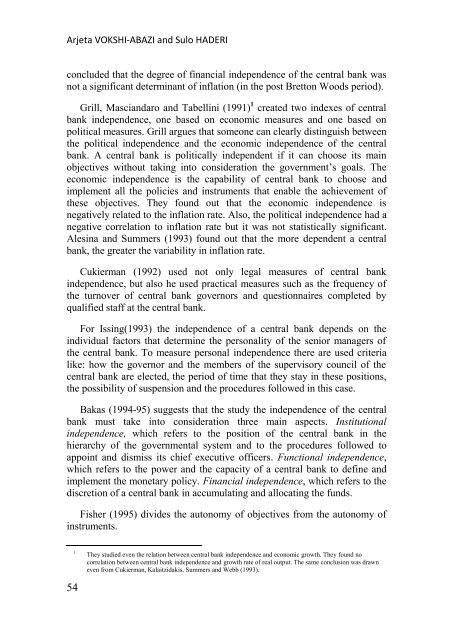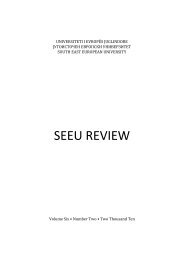SEEU Review vol. 5 Nr. 2 (pdf) - South East European University
SEEU Review vol. 5 Nr. 2 (pdf) - South East European University
SEEU Review vol. 5 Nr. 2 (pdf) - South East European University
Create successful ePaper yourself
Turn your PDF publications into a flip-book with our unique Google optimized e-Paper software.
Arjeta VOKSHI-ABAZI and Sulo HADERI<br />
concluded that the degree of financial independence of the central bank was<br />
not a significant determinant of inflation (in the post Bretton Woods period).<br />
Grill, Masciandaro and Tabellini (1991) 1 created two indexes of central<br />
bank independence, one based on economic measures and one based on<br />
political measures. Grill argues that someone can clearly distinguish between<br />
the political independence and the economic independence of the central<br />
bank. A central bank is politically independent if it can choose its main<br />
objectives without taking into consideration the government’s goals. The<br />
economic independence is the capability of central bank to choose and<br />
implement all the policies and instruments that enable the achievement of<br />
these objectives. They found out that the economic independence is<br />
negatively related to the inflation rate. Also, the political independence had a<br />
negative correlation to inflation rate but it was not statistically significant.<br />
Alesina and Summers (1993) found out that the more dependent a central<br />
bank, the greater the variability in inflation rate.<br />
Cukierman (1992) used not only legal measures of central bank<br />
independence, but also he used practical measures such as the frequency of<br />
the turnover of central bank governors and questionnaires completed by<br />
qualified staff at the central bank.<br />
For Issing(1993) the independence of a central bank depends on the<br />
individual factors that determine the personality of the senior managers of<br />
the central bank. To measure personal independence there are used criteria<br />
like: how the governor and the members of the supervisory council of the<br />
central bank are elected, the period of time that they stay in these positions,<br />
the possibility of suspension and the procedures followed in this case.<br />
Bakas (1994-95) suggests that the study the independence of the central<br />
bank must take into consideration three main aspects. Institutional<br />
independence, which refers to the position of the central bank in the<br />
hierarchy of the governmental system and to the procedures followed to<br />
appoint and dismiss its chief executive officers. Functional independence,<br />
which refers to the power and the capacity of a central bank to define and<br />
implement the monetary policy. Financial independence, which refers to the<br />
discretion of a central bank in accumulating and allocating the funds.<br />
Fisher (1995) divides the autonomy of objectives from the autonomy of<br />
instruments.<br />
1<br />
54<br />
They studied even the relation between central bank independence and economic growth. They found no<br />
correlation between central bank independence and growth rate of real output. The same conclusion was drawn<br />
even from Cukierman, Kalaitzidakis, Summers and Webb (1993).

















